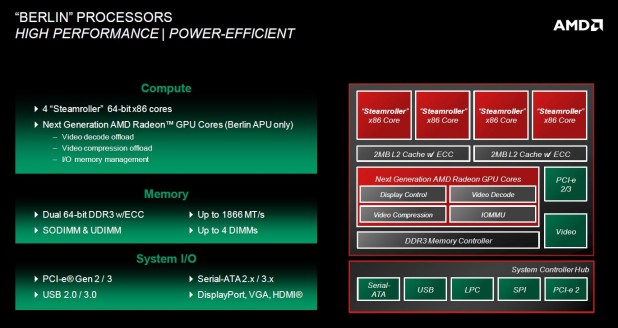 AMD's upcoming server processors include "Berlin," an x86-based quad-core designed to function either as a low-power CPU or integrated GPU.[/caption] AMD has laid out a server-processor roadmap it hopes will allow it to take market-share from archrival Intel. The first product to appear will be a 64-bit system-on-a-chip (SoC) code-named "Seattle," which will ship to manufacturers in 2014. The new chip will be a fully 64-bit, eight-core processor based on ARM's Cortex-A57 chip architecture, which will deliver two to four times the performance of the current "Kyoto" version of AMD's Opteron X-series chips, with better power efficiency. Most Opterons contain four cores rather than the eight in Seattle, which could explain the boost in power. Later versions of Seattle will contain 16 cores. The initial version of Seattle will run at a frequency of 2GHz or higher and support up to 128GB of RAM, integrated 10Gbit/sec Ethernet NICs; it will be the first AMD processor to support the "Freedom Fabric" interconnect AMD acquired along with SeaMicro last year. Freedom Fabric is an interconnect designed to link a large number of servers, storage units and networking systems into a cluster or integrated network. It features an intelligent controller with dedicated ASIC processors embedded within the AMD chipset, to reduce latency and keep bandwidth high for high-density server clusters and high-performance storage hardware. Freedom Fabric is rated with 1.28 Tbit/sec of bandwidth inside the server, which works out to a transfer speed of about 1.25GB/sec. Seattle will go into production during the second half of 2013, according to the chip roadmap AMD laid out this week. AMD also announced plans for a pair of other server processors. The first, "Berlin," is an x86-based quad-core designed to function either as a low-power CPU or integrated GPU. It is based on AMD's "Steamroller" architecture and will support Uniform Memory Access. The more ambitious server processor, "Warsaw," is also an x86 based on AMD's "Piledriver" architecture and will ship with either 12- or 16 cores. It is designed as a high power-per-watt processor for servers with either two or four sockets and to be an easy, socket-compatible upgrade to AMD's current Opteron 6300 processors. Financial analyst David Wong of Wells Fargo wrote that the new chips are consistent with the view that AMD is targeting market niches like that for two- and four-socket server, in which it can be more competitive with Intel. The tactic "will help AMD reach a level of sustained profitability in a reasonable period of time," according to portions of his analysis quoted in Barron's. Doug Freedman of RBC Capital Markets, on the other hand, wrote that AMD is dividing its limited R&D budget among too many projects, resulting in a lack of focus that could make it difficult for AMD to take back market share from Intel. Image: AMD
AMD's upcoming server processors include "Berlin," an x86-based quad-core designed to function either as a low-power CPU or integrated GPU.[/caption] AMD has laid out a server-processor roadmap it hopes will allow it to take market-share from archrival Intel. The first product to appear will be a 64-bit system-on-a-chip (SoC) code-named "Seattle," which will ship to manufacturers in 2014. The new chip will be a fully 64-bit, eight-core processor based on ARM's Cortex-A57 chip architecture, which will deliver two to four times the performance of the current "Kyoto" version of AMD's Opteron X-series chips, with better power efficiency. Most Opterons contain four cores rather than the eight in Seattle, which could explain the boost in power. Later versions of Seattle will contain 16 cores. The initial version of Seattle will run at a frequency of 2GHz or higher and support up to 128GB of RAM, integrated 10Gbit/sec Ethernet NICs; it will be the first AMD processor to support the "Freedom Fabric" interconnect AMD acquired along with SeaMicro last year. Freedom Fabric is an interconnect designed to link a large number of servers, storage units and networking systems into a cluster or integrated network. It features an intelligent controller with dedicated ASIC processors embedded within the AMD chipset, to reduce latency and keep bandwidth high for high-density server clusters and high-performance storage hardware. Freedom Fabric is rated with 1.28 Tbit/sec of bandwidth inside the server, which works out to a transfer speed of about 1.25GB/sec. Seattle will go into production during the second half of 2013, according to the chip roadmap AMD laid out this week. AMD also announced plans for a pair of other server processors. The first, "Berlin," is an x86-based quad-core designed to function either as a low-power CPU or integrated GPU. It is based on AMD's "Steamroller" architecture and will support Uniform Memory Access. The more ambitious server processor, "Warsaw," is also an x86 based on AMD's "Piledriver" architecture and will ship with either 12- or 16 cores. It is designed as a high power-per-watt processor for servers with either two or four sockets and to be an easy, socket-compatible upgrade to AMD's current Opteron 6300 processors. Financial analyst David Wong of Wells Fargo wrote that the new chips are consistent with the view that AMD is targeting market niches like that for two- and four-socket server, in which it can be more competitive with Intel. The tactic "will help AMD reach a level of sustained profitability in a reasonable period of time," according to portions of his analysis quoted in Barron's. Doug Freedman of RBC Capital Markets, on the other hand, wrote that AMD is dividing its limited R&D budget among too many projects, resulting in a lack of focus that could make it difficult for AMD to take back market share from Intel. Image: AMD AMD 'Seattle' Adds High-Speed Interconnect to Non-x86 Processors
[caption id="attachment_10507" align="aligncenter" width="618"]  AMD's upcoming server processors include "Berlin," an x86-based quad-core designed to function either as a low-power CPU or integrated GPU.[/caption] AMD has laid out a server-processor roadmap it hopes will allow it to take market-share from archrival Intel. The first product to appear will be a 64-bit system-on-a-chip (SoC) code-named "Seattle," which will ship to manufacturers in 2014. The new chip will be a fully 64-bit, eight-core processor based on ARM's Cortex-A57 chip architecture, which will deliver two to four times the performance of the current "Kyoto" version of AMD's Opteron X-series chips, with better power efficiency. Most Opterons contain four cores rather than the eight in Seattle, which could explain the boost in power. Later versions of Seattle will contain 16 cores. The initial version of Seattle will run at a frequency of 2GHz or higher and support up to 128GB of RAM, integrated 10Gbit/sec Ethernet NICs; it will be the first AMD processor to support the "Freedom Fabric" interconnect AMD acquired along with SeaMicro last year. Freedom Fabric is an interconnect designed to link a large number of servers, storage units and networking systems into a cluster or integrated network. It features an intelligent controller with dedicated ASIC processors embedded within the AMD chipset, to reduce latency and keep bandwidth high for high-density server clusters and high-performance storage hardware. Freedom Fabric is rated with 1.28 Tbit/sec of bandwidth inside the server, which works out to a transfer speed of about 1.25GB/sec. Seattle will go into production during the second half of 2013, according to the chip roadmap AMD laid out this week. AMD also announced plans for a pair of other server processors. The first, "Berlin," is an x86-based quad-core designed to function either as a low-power CPU or integrated GPU. It is based on AMD's "Steamroller" architecture and will support Uniform Memory Access. The more ambitious server processor, "Warsaw," is also an x86 based on AMD's "Piledriver" architecture and will ship with either 12- or 16 cores. It is designed as a high power-per-watt processor for servers with either two or four sockets and to be an easy, socket-compatible upgrade to AMD's current Opteron 6300 processors. Financial analyst David Wong of Wells Fargo wrote that the new chips are consistent with the view that AMD is targeting market niches like that for two- and four-socket server, in which it can be more competitive with Intel. The tactic "will help AMD reach a level of sustained profitability in a reasonable period of time," according to portions of his analysis quoted in Barron's. Doug Freedman of RBC Capital Markets, on the other hand, wrote that AMD is dividing its limited R&D budget among too many projects, resulting in a lack of focus that could make it difficult for AMD to take back market share from Intel. Image: AMD
AMD's upcoming server processors include "Berlin," an x86-based quad-core designed to function either as a low-power CPU or integrated GPU.[/caption] AMD has laid out a server-processor roadmap it hopes will allow it to take market-share from archrival Intel. The first product to appear will be a 64-bit system-on-a-chip (SoC) code-named "Seattle," which will ship to manufacturers in 2014. The new chip will be a fully 64-bit, eight-core processor based on ARM's Cortex-A57 chip architecture, which will deliver two to four times the performance of the current "Kyoto" version of AMD's Opteron X-series chips, with better power efficiency. Most Opterons contain four cores rather than the eight in Seattle, which could explain the boost in power. Later versions of Seattle will contain 16 cores. The initial version of Seattle will run at a frequency of 2GHz or higher and support up to 128GB of RAM, integrated 10Gbit/sec Ethernet NICs; it will be the first AMD processor to support the "Freedom Fabric" interconnect AMD acquired along with SeaMicro last year. Freedom Fabric is an interconnect designed to link a large number of servers, storage units and networking systems into a cluster or integrated network. It features an intelligent controller with dedicated ASIC processors embedded within the AMD chipset, to reduce latency and keep bandwidth high for high-density server clusters and high-performance storage hardware. Freedom Fabric is rated with 1.28 Tbit/sec of bandwidth inside the server, which works out to a transfer speed of about 1.25GB/sec. Seattle will go into production during the second half of 2013, according to the chip roadmap AMD laid out this week. AMD also announced plans for a pair of other server processors. The first, "Berlin," is an x86-based quad-core designed to function either as a low-power CPU or integrated GPU. It is based on AMD's "Steamroller" architecture and will support Uniform Memory Access. The more ambitious server processor, "Warsaw," is also an x86 based on AMD's "Piledriver" architecture and will ship with either 12- or 16 cores. It is designed as a high power-per-watt processor for servers with either two or four sockets and to be an easy, socket-compatible upgrade to AMD's current Opteron 6300 processors. Financial analyst David Wong of Wells Fargo wrote that the new chips are consistent with the view that AMD is targeting market niches like that for two- and four-socket server, in which it can be more competitive with Intel. The tactic "will help AMD reach a level of sustained profitability in a reasonable period of time," according to portions of his analysis quoted in Barron's. Doug Freedman of RBC Capital Markets, on the other hand, wrote that AMD is dividing its limited R&D budget among too many projects, resulting in a lack of focus that could make it difficult for AMD to take back market share from Intel. Image: AMD
 AMD's upcoming server processors include "Berlin," an x86-based quad-core designed to function either as a low-power CPU or integrated GPU.[/caption] AMD has laid out a server-processor roadmap it hopes will allow it to take market-share from archrival Intel. The first product to appear will be a 64-bit system-on-a-chip (SoC) code-named "Seattle," which will ship to manufacturers in 2014. The new chip will be a fully 64-bit, eight-core processor based on ARM's Cortex-A57 chip architecture, which will deliver two to four times the performance of the current "Kyoto" version of AMD's Opteron X-series chips, with better power efficiency. Most Opterons contain four cores rather than the eight in Seattle, which could explain the boost in power. Later versions of Seattle will contain 16 cores. The initial version of Seattle will run at a frequency of 2GHz or higher and support up to 128GB of RAM, integrated 10Gbit/sec Ethernet NICs; it will be the first AMD processor to support the "Freedom Fabric" interconnect AMD acquired along with SeaMicro last year. Freedom Fabric is an interconnect designed to link a large number of servers, storage units and networking systems into a cluster or integrated network. It features an intelligent controller with dedicated ASIC processors embedded within the AMD chipset, to reduce latency and keep bandwidth high for high-density server clusters and high-performance storage hardware. Freedom Fabric is rated with 1.28 Tbit/sec of bandwidth inside the server, which works out to a transfer speed of about 1.25GB/sec. Seattle will go into production during the second half of 2013, according to the chip roadmap AMD laid out this week. AMD also announced plans for a pair of other server processors. The first, "Berlin," is an x86-based quad-core designed to function either as a low-power CPU or integrated GPU. It is based on AMD's "Steamroller" architecture and will support Uniform Memory Access. The more ambitious server processor, "Warsaw," is also an x86 based on AMD's "Piledriver" architecture and will ship with either 12- or 16 cores. It is designed as a high power-per-watt processor for servers with either two or four sockets and to be an easy, socket-compatible upgrade to AMD's current Opteron 6300 processors. Financial analyst David Wong of Wells Fargo wrote that the new chips are consistent with the view that AMD is targeting market niches like that for two- and four-socket server, in which it can be more competitive with Intel. The tactic "will help AMD reach a level of sustained profitability in a reasonable period of time," according to portions of his analysis quoted in Barron's. Doug Freedman of RBC Capital Markets, on the other hand, wrote that AMD is dividing its limited R&D budget among too many projects, resulting in a lack of focus that could make it difficult for AMD to take back market share from Intel. Image: AMD
AMD's upcoming server processors include "Berlin," an x86-based quad-core designed to function either as a low-power CPU or integrated GPU.[/caption] AMD has laid out a server-processor roadmap it hopes will allow it to take market-share from archrival Intel. The first product to appear will be a 64-bit system-on-a-chip (SoC) code-named "Seattle," which will ship to manufacturers in 2014. The new chip will be a fully 64-bit, eight-core processor based on ARM's Cortex-A57 chip architecture, which will deliver two to four times the performance of the current "Kyoto" version of AMD's Opteron X-series chips, with better power efficiency. Most Opterons contain four cores rather than the eight in Seattle, which could explain the boost in power. Later versions of Seattle will contain 16 cores. The initial version of Seattle will run at a frequency of 2GHz or higher and support up to 128GB of RAM, integrated 10Gbit/sec Ethernet NICs; it will be the first AMD processor to support the "Freedom Fabric" interconnect AMD acquired along with SeaMicro last year. Freedom Fabric is an interconnect designed to link a large number of servers, storage units and networking systems into a cluster or integrated network. It features an intelligent controller with dedicated ASIC processors embedded within the AMD chipset, to reduce latency and keep bandwidth high for high-density server clusters and high-performance storage hardware. Freedom Fabric is rated with 1.28 Tbit/sec of bandwidth inside the server, which works out to a transfer speed of about 1.25GB/sec. Seattle will go into production during the second half of 2013, according to the chip roadmap AMD laid out this week. AMD also announced plans for a pair of other server processors. The first, "Berlin," is an x86-based quad-core designed to function either as a low-power CPU or integrated GPU. It is based on AMD's "Steamroller" architecture and will support Uniform Memory Access. The more ambitious server processor, "Warsaw," is also an x86 based on AMD's "Piledriver" architecture and will ship with either 12- or 16 cores. It is designed as a high power-per-watt processor for servers with either two or four sockets and to be an easy, socket-compatible upgrade to AMD's current Opteron 6300 processors. Financial analyst David Wong of Wells Fargo wrote that the new chips are consistent with the view that AMD is targeting market niches like that for two- and four-socket server, in which it can be more competitive with Intel. The tactic "will help AMD reach a level of sustained profitability in a reasonable period of time," according to portions of his analysis quoted in Barron's. Doug Freedman of RBC Capital Markets, on the other hand, wrote that AMD is dividing its limited R&D budget among too many projects, resulting in a lack of focus that could make it difficult for AMD to take back market share from Intel. Image: AMD 

